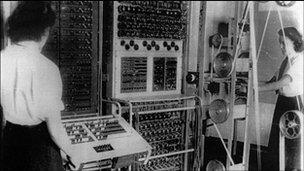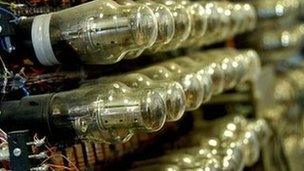The road to uncovering a wartime Colossus
- Published

The first official information released about Colossus was a single page of information and a few pictures
The story of how the Colossus computer at Bletchley Park aided the allied code-cracking effort during World War II is becoming well known. Its claim to be a forerunner of modern-day computers is also well established.
What is much less well known is the tale of how Colossus's story came to be told in the first place. It is a tale of how one man's dogged efforts overcame official secrets and official indifference to rewrite computer history.
Computer scientist Brian Randell was the man who started uncovering the history of Colossus.
That history had to be prised out of the archives because official efforts to cover up its success worked so well. Thousands of people worked in the huts at Bletchley Park during WWII on code-cracking but only a handful were involved with Colossus and fewer still knew everything about it. All those codebreakers signed the Official Secrets Act which demanded that they kept quiet about their wartime career.
Almost all the machines were broken up once they ceased to be useful and design documents were burnt or destroyed at the same time.
"I got to know more about it than they did," Prof Randell told the BBC. "They were so compartmentalised that those who worked in one hut would not dream of talking to people in another hut." Prof Randell detailed his experiences of uncovering Colossus' history during a talk at The National Museum of Computing at Bletchley Park.
Sensitive operation
Prof Randell tripped over the story of Colossus in 1970 while preparing an academic paper on a little-known Irish computer pioneer Percy Ludgate who, in 1908, completed the design for a nascent computer.
Because he had a lot of material left over after writing about Ludgate, Mr Randell decided to use it as the basis of a series of papers dealing with early computers.
While putting those papers together, he was asked why he had written so little about Alan Turing. Prof Randell started to look into Turing's war work and got tantalising glimpses of the electronic code-cracking machines that had been in use at Bletchley.
One paper written by Jack Good, one of the engineers who helped create Colossus, and published in 1970 mentioned a "classified, electronic" machine that used 1,000 valves to calculate "complicated Boolean functions involving up to about 100 symbols" to crack codes.
The link with Turing, said Prof Randell, was that Colossus drew on Turing's seminal 1936 paper that laid down the basic specifications for a machine that could carry out complicated calculations step by step.
Finding a little out about this machine prompted Prof Randell to seek out and correspond with those named as being involved with Colossus even though he now knew that their work was covered by the Official Secrets Act.
"A number of the people I wrote to wrote back in very guarded terms," said Prof Randell. "We were very much more conscious about those things at that time."
The result of Prof Randell's work was a paper in 1972 exploring Turing's influence on early computers and making mention of the wartime machines.

Prof Randell's work aided the reconstruction of the Colossus computer
In a bid to pierce the official veil of secrecy, Prof Randell wrote to the prime minister of the day, Ted Heath, asking for more information to be released.
He was turned down flat.
Information could not be released, said Mr Heath, because that "sensitive wartime operation... still has important current implications".
Modest men
Prof Randell continued to badger civil servants and his efforts were helped by the appearance of several books about Bletchley and code-cracking that mentioned the machines used to read messages sent by the Wermacht, Luftwaffe and Hitler's generals.
Then, in 1975, a change of government brought a change in policy and Prof Randell was invited to the Cabinet Office to discuss the first official release of information about the Allies' main codebreaking machine.
The official release was a handful of pictures and a short statement which mentioned Colossus' key designers: Max Newman and Tommy Flowers. More importantly, Prof Randell was asked by the government to interview the Colossus creators and publish what they said.
Prof Randell gathered the information into a paper that he presented in 1976 at a conference on the history of computing. Attending was John Mauchly who, before Prof Randell took to the stage, thought that the machine he built, Eniac, was one of the first electronic computers.
Jaws literally dropped as Prof Randell delivered his lecture, he told the BBC. They dropped again in the evening as Prof Randell had arranged for one of Colossus's creators, Allen "Doc" Coombs, to attend and answer questions about the machine and what it did.
Prof Randell's lecture and Coombs's comments meant the computer history books would have to be rewritten.
"Eniac was not the first computer, it was the 11th," he said.
The door that Prof Randell first pushed at is now wide open, he said.
"I'm sure that all of the technical details of Colossus are now well known," said Prof Randell. "With the publication of the official history of the intelligence services we have a very full account of what was discovered by codebreaking and the significance it had."
It has also put the spotlight on the people who built Colossus and their achievements.
"They were so modest and so bloody brilliant," he said. "It was one of the best experiences of my life."
- Published19 April 2012
- Published9 January 2013
- Published20 November 2012
- Published18 January 2013
- Published9 March 2012